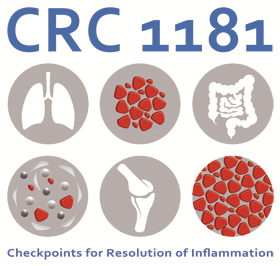Discovering the secret of gallstones

It is already known from Grimm’s story that stones in the stomach are detrimental to well-being. But while Grimm places the stones in the belly of the wolf, our body cunningly forms them by itself. How stones are formed in the body, however, was previously unknown despite the fact that gallstones are one of the ten most common reasons for hospitalization. The secret of the gallstones has now been revealed by a research team from Medical Clinics 1 and 3 at the FAU University Hospital. The findings were published in the journal Immunity*.
Stone diseases are very common. About 25 million Americans and about six million Germans suffer from gallstones, which can lead not only to extremely painful colic, but also to life-long inflammations in the abdominal cavity. Stone diseases very often require a surgical procedure to remove these foreign bodies. Surprisingly, nothing is known about how stones are formed and how they are composed. Although it was known that crystals are involved in the formation of stones, in the case of gallstones it is usually cholesterol crystals. How a microscopically small crystal becomes a stone, however, had not yet been researched and has now been explained.
The team led by Dr. Luis Munoz, Sebastian Böltz and Prof. Dr. Martin Herrmann from the Department of Internal Medicine 3, who collaborated in the Collaborative Research Centre 1181 and the German Centre Immunotherapy (DZI) and were supported by a team led by Dr. Moritz Leppkes and Prof. Dr. Markus F. Neurath, Department of Internal Medicine 1 of the FAU, followed an unconventional path that led them to museums, slaughterhouses and operating theatres. They examined human stones from the museum collection of the Charité in Berlin, bile from pigs from the slaughterhouse and stones and bile from patients who underwent abdominal surgery. The team was able to make a very surprising discovery in the detailed examination of this material using state-of-the-art methods: All gallstones are covered with traces of a special form of white blood cells – neutrophil granulocytes. These cells are the body’s first defensive front and not only attack bacteria and other germs, but also recognise crystals as a danger. When they try to absorb them, they die and put their genetic material over the crystals like a net. These nets – NETs for Neutrophil Extracellular Traps – wrap around the crystals, clumping them together and creating stones that can sometimes take on amazing proportions.
“We observed that the released networks clump together in the already sticky bile, calcium and cholesterol crystals and thus form gallstones. If the formation of networks is pharmacologically inhibited, the formation of gallstones can be greatly reduced or even eliminated,” says Dr. Munoz. This discovery opens up new possibilities in the treatment of gallstones. A simple pharmacological approach might be of interest: the use of metoprolol, a beta-blocker that has been successfully used for many years to treat high blood pressure. Metoprolol prevents neutrophil granulocytes from entering the tissue from the bloodstream and thus reduces the capacity to form networks and thus gallstones. In addition, specific inhibitors of neutrophil granulocyte net formation, known as PAD inhibitors, are known to inhibit the formation of experimentally induced gallstones very efficiently and have thus been able to prove the importance of the immune system in the formation of these structures. The FAU research team also points out that this process is of central importance not only for gallstones, but also for other stone diseases such as kidney stones or salivary gland stones.
*DOI: https://doi.org/10.1016/j.immuni.2019.07.002
Further Information:
Dr. Luis Munoz
Tel.: 09131/85-36990
luis.munoz@uk-erlangen.de
